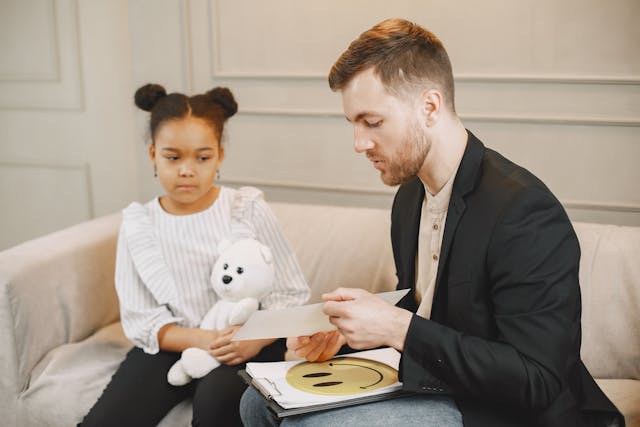The struggle of keeping teens and kids engaged
Keeping teens and kids engaged in therapy is a significant challenge, especially with the increasing influence of technology and social media. The rapid evolution of these platforms has made it even more difficult for young patients to open up, making traditional therapy methods less effective. Many teens and children find it hard to be vulnerable with their own family members and friends, let alone with a therapist they barely know.
To address this, we've compiled a list of 15 effective therapeutic exercises that are easy to facilitate and less invasive than other practices. These activities are designed to increase teen participation and help young clients communicate without fear of judgment. They can be used alongside related therapy worksheets to enhance the therapeutic process and make it more engaging for teens and children.
If you're struggling to explore a client's mental health issues and help them express their honest feelings, these therapy activities for teens and kids could be the solution you've been looking for.
How do therapy activities for teens and kids benefit mental health?
Therapy offers a multitude of benefits for teens and kids, improving mental health and resolving behavioral issues. For instance, with mental health treatment, children and teens develop coping skills to better manage any symptoms impairing their day-to-day functioning. This treatment also fosters increased self-awareness, helping them gain a greater self-awareness and deeper understanding of themselves, which enhances mental clarity and promotes personal growth. They can build a solid foundation to help each day feel manageable and produce positive emotions and healthy outlooks more often.
Puberty can be an incredibly turbulent time—therapy allows children and teens to learn how to cope and better understand the thoughts and feelings that they may have. In therapy, they can learn to express their emotions more effectively, which also works to strengthen relationships and communication skills with others.
With therapy, children and teenagers can resolve conflicts quickly, promote higher self-esteem and confidence, and have coping skills to be more resistant to peer pressure. Therapists identify negative thought patterns and habits and transform them to help clients overcome trauma and process complex emotions healthily.
Effective therapy activities for teens and kids
To help you get on the right track, we’ve collated a list of 15 of the most helpful therapy activities for teens and children that can increase engagement and clinical outcomes. These activities include creative approaches like art and music therapy, and you can do these in traditional individual therapy or group therapy. Let’s get started!
1. My life playlist
For the music-inclined, this activity allows clients to express their feelings and thoughts through music. Teens create a playlist of their favorite songs based on a theme, such as their concerns, goals, or self-esteem. Listening and discussing these songs can help them articulate their emotions and experiences, providing a fun and engaging way to open up.
2. A letter to myself
This activity involves teenagers writing a letter for another version of themselves. It can be a letter from their future self to their current selves, or vice versa, or even a letter from their present self to their past self. It encourages reflection on their present self, current issues, and hopes for the future, helping them gain perspective and confidence in their ability to overcome challenges. Guiding them through this exercise can reveal their current self, thoughts, and aspirations, making it easier to address their present concerns.
3. Outdoor therapy sessions
Walking-and-talking therapy sessions offer a casual setting that can help clients open up. Go for a walk with your client through a nearby park or neighborhood, facilitating casual conversation. The fresh air and natural light can enhance mood, making it easier for teens to discuss deeper issues while feeling less confined.
4. Mindful speaking
This exercise teaches children and teenagers to think before they speak. Encourage them to slow down, analyze emotionally and rationally, and reflect on their own emotions and the effects of their words. Using examples from TV shows or real-life situations can make the activity engaging and relatable, promoting mindfulness and better communication skills.
5. Identifying strengths
This activity helps teens recognize their strengths by sharing stories of achievements. Ask them to recall a time they achieved something, big or small, and discuss the strengths demonstrated in their self-reflection or story. This can boost self-esteem and help them see their capabilities positively. In group therapy, receiving peer feedback can also help teens recognize their strengths more easily. You can also chime in with feedback yourself.
6. Gratitude mapping
If you are facilitating a group, divide them into smaller groups then ask them to write down things they are grateful for in the present moment. Each group then moves to other groups to draw connections between the ideas. This activity fosters an appreciation for the positive aspects of life and enhances self-esteem. Conclude the therapy session by reflecting on the importance of gratitude. Group therapy activities like gratitude mapping can foster appreciation and connection among participants.
7. Playing two truths and a lie
This fun icebreaker promotes self-awareness, creativity, and social skills. To play it, ask the teens to share two truths and one lie about themselves. Other group members guess which one is the lie. This interaction helps improve social skills and fosters positive relationships among participants, enabling them to connect with their peers during the activity. Additionally, this engaging activity encourages participants to think about themselves.
8. Making a creative collage for self-expression
In this activity, the teens are asked to create collages representing their core values and beliefs using images, words, and colors. Provide magazines, old books, art mediums, and newspapers as materials. This artistic activity can encourage self-expression and help them explore and communicate their inner thoughts and feelings in a visually engaging way.
9. Candy game
Provide candies of different colors, then assign each color to a different prompt related to emotions like anger, joy, and sadness. Teens answer the prompts associated with the candy color they choose. This game can encourage reflection and discussion in a group setting in a structured yet fun way.
10. Exploding balloons
Aimed at managing anger, this activity involves inflating a balloon. Ask your client to talk about anger-triggering events, and blow into the balloon as they are talking until it pops. After that, get another balloon, and ask them to talk about their issues and then their feelings. Let some air out of the balloon to symbolize releasing their anger. This visual and physical activity helps manage anger constructively.
11. Yoga
Yoga integrates physical postures, meditation, and deep breathing techniques to promote and improve emotional and mental health. Start with simple poses like the mountain or child’s pose, gradually moving to more advanced ones. You can do this in individual sessions, but group yoga sessions are better as they promote emotional and mental health by fostering connection and understanding among participants.
12. Board games and tabletop games
Playing board games can reveal decision-making, problem-solving skills, and relational dynamics. Group activities like Ticket to Ride and Codenames encourage communication and social interaction, promoting the development of social skills. The way each participant interacts with other players provides insight into their character and critical thinking skills.
13. Painting and drawing
Art therapy that involves drawing or painting as a form of self-expression lets your client communicate emotions and thoughts. Clients can work on a specific theme or their current feelings. This non-invasive activity allows clients to open up and discuss their emotions through verbal expression and their artistic process.
14. Anger menu
Create a folded menu titled "The Anger Menu" filled with healthy ways to express anger. Have clients also come up with new healthy options for expressing anger. This activity helps with emotional regulation by offering alternative ways to manage anger.
15. Cooking/baking
Engage teens in cooking or baking to encourage mindfulness and creativity. They can follow a recipe and discuss how the process relates to their feelings and thoughts. This activity promotes relaxation and provides a sense of accomplishment. Group therapy activities like group cooking sessions can encourage mindfulness and creativity through collaborative experiences.
Take home message
It can be very daunting for teenagers and children to come to therapy. Specifically, some children may feel embarrassed or ashamed about it, and some teens may express being intimidated to open up to someone with whom they do not have a previous relationship. It can be challenging to encourage participation, but these 15 therapy activities for teens and kids aim to give them greater confidence in expressing their thoughts and feelings.
Remember, the goal is to make therapy a positive and empowering experience that they look forward to. Integrate these activities into your practice today and witness their transformative impact on your young clients' to improve mental health and emotional regulation.

.webp)






.jpg)


.jpg)




.jpg)


.jpg)
.jpg)


.jpg)
.jpg)


.jpg)
